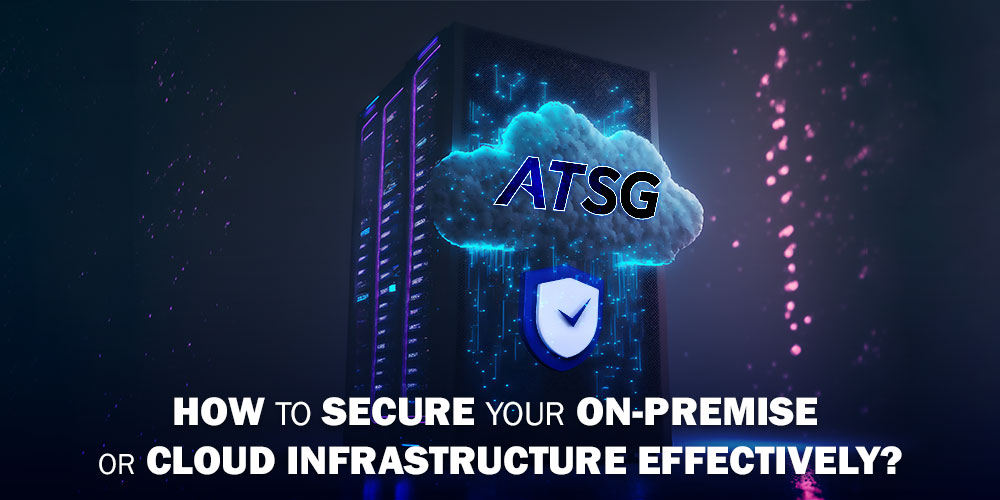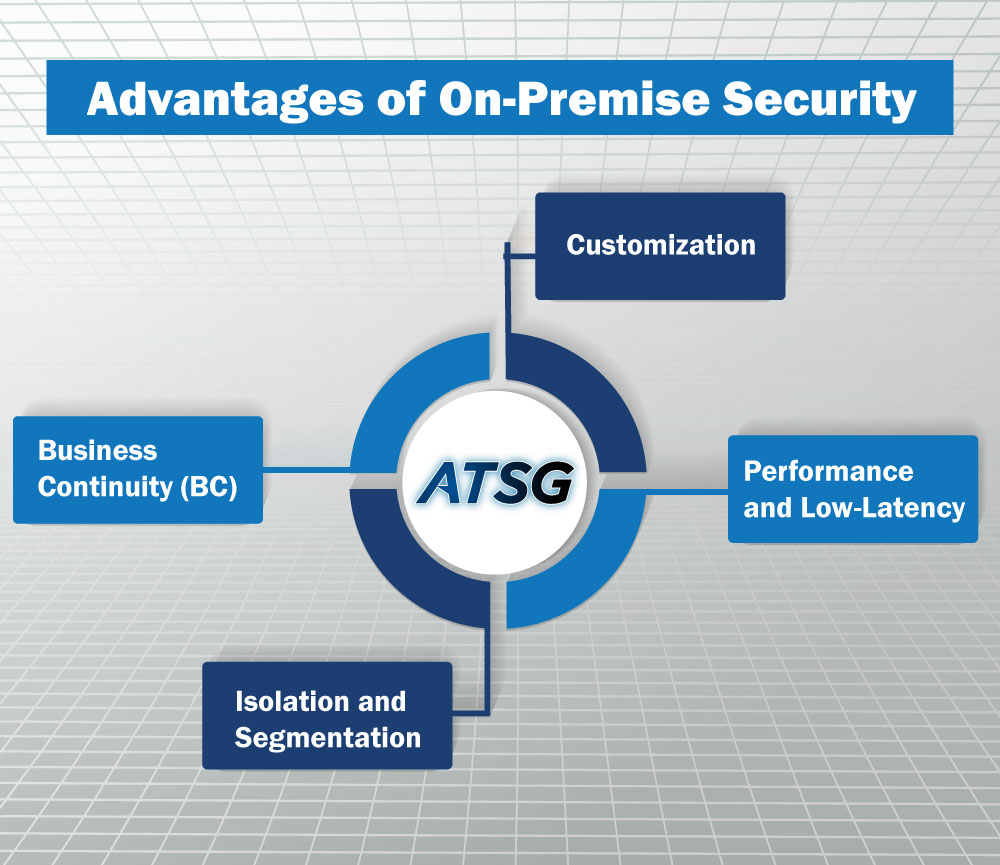Businesses today continuously face the challenge of integrating solutions that operate on-premise, and over cloud infrastructures. The popularity of Cloud Solutions has prompted many organizations to transition their IT systems. However, on-premise infrastructures still remain relevant. With technology, every solution and infrastructure has its advantages and downsides. With the help of Managed Service Providers (MSPs), organizations can find the right solution that would fit their needs and requirements to grow and improve business processes.

What is Cloud Security?
Cloud security is a collection of procedures and technologies designed to address external and internal threats to Cybersecurity. Organizations need cloud security as they move towards their digital transformation strategy, and incorporate cloud-based tools and services. It operates as a set of policies, strategies, controls, procedures, and practices to safeguard the data, resources and applications hosted in the Cloud.
Why is Cloud Security Important?
In modern-day enterprises, the transition towards cloud solutions and environments is increasing. As companies continue to migrate to the Cloud, understanding their security requirements for keeping data safe has become critical. While third-party cloud providers may take on the management of the infrastructure, the responsibility and accountability partly remains with the deploying organization.
Security threats have become more advanced, as the digital landscape continues to evolve. These threats do target cloud providers, in addition to on-premise IT infrastructures. Without taking proactive steps to improve cloud security, organizations and service providers can face challenges.
Benefits of Integrating Cloud Security
Cloud security offers several benefits to organizations. Here are some key advantages of implementing cloud security measures.
Data Protection
Cloud security measures, such as encryption, access control, user authentication and data backup help protect sensitive data from un-authorized access, theft or loss.
Scalability and Flexibility
Solutions such as cloud security can scale and adapt to the changing needs of organizations. Cloud environments allow for easy provisioning and de-provisioning of resources, enabling organizations to quickly adjust their security measures, as their requirements evolve.
Cost Saving
It eliminates the need for organizations to invest heavily in on-premise security infrastructures, hardware and software. Cloud security services can benefit organizations from economies of scale.
Reliability
Cloud service providers (CSPs) typically offer robust infrastructure and redundant systems, ensuring high availability and reliability of security measures. Redundancy across multiple data centers that are geographically distributed, help mitigate the risk of data loss or service disruption.
Centralized Management and Control
Cloud security platforms often provide centralized management, intuitive consoles or dashboards, allowing organizations to monitor and configure security policies across the cloud environments from a single interface.
Access to Advanced Technologies
With cloud security, cutting-edge technology is being integrated across different platforms. Organizations can benefit from advanced threat detection systems, machine learning (ML) algorithms, and Artificial Intelligence (AI). These technologies enhance the ability to detect and respond to security threats effectively.
Regulatory Compliance
Cloud service providers (CSPs) often have extensive experience in adhering to industry-specific compliance requirements and regulatory standards. By leveraging their services, organizations can take advantage of the provider’s compliance certifications and security controls, helping them in meeting their compliance needs more efficiently.
How to Integrate Cloud Security?
Approaching cloud security works differently for every organization, based on the requirements. However, there are several steps that experts and professionals have identified as essential to ensuring secure and best-use practices for cloud security. Experts highlight that organizations need to implement the five pillars of a cybersecurity framework; Identify, protect, detect, respond, and recover. With this, organizations can ensure their preparations and prevention methods are adequate.
Another aspect of cloud security is integrating Cloud Security Posture Management (CSPM). This particular solution is designed to address the common flaw of misconfigurations in a cloud infrastructure. These can lead to several vulnerabilities and increase the overall attack surface. CSPM helps organize and deploy core components of cloud security to mitigate the chances of attacks. These include Identity and access management (IAM), regulatory compliance, traffic monitoring and threat response etc.
What is On-Premise Security?
On-premise security refers to both the rules and tools in place to protect the security and accessibility of computer networks, including hardware and software. Ensuring the security of data, assets, resources, and other factors within the physical infrastructure is called on-premise security.
Advantages of On-Premise Security
On-premise solutions are part of every organization, and are believed to be un-avoidable at times. The following list explores the benefits of on-premise security.

Customization
On-premise security allows organizations to customize security measures to meet specific needs and requirements. They can choose and configure security solutions, protocols, and policies tailored to each unique environment.
Performance and Low-Latency
By keeping security measures within the organization’s infrastructure, organizations can benefit from fast response times, reduced network latency, and optimized resource allocation.
Isolation and Segmentation
On premise security allows organizations to implement strict network segmentation in isolation, ensuring that sensitive systems and data are separated from rest of the network. This reduces the risk of lateral movement by attackers, and limits the potential impact of security breaches.
Business Continuity (BC)
On-Premise security allows organizations to have direct control over their backup and disaster recovery (DR) strategies. They can design and implement robust business continuity (BC) plans tailored to their specific needs, ensuring availability, minimizing downtime, and accelerating recovery times during un-expected events.
Challenges of On-Premise Security
On premise solutions will have a vital role in some organizations. However, with the evolution of technology and innovative methods, on-premise solutions face multiple challenges.

The following list explores how on premise security solutions have several drawbacks.
Poor Security
With cyber attackers already well aware of how traditional, legacy security mechanisms work, it is easier to breach them and exploit the opportunity.
On-Site Management
Due to the lack of remote access, on-premise security may not be able to resolve issues once the IT team has left the office. With the need for continuous supervision and management, on-Premise solutions are not that effective.
Lagging Scalability
With organizations wanting to be able to control their scalability levels, on-premise security solutions may not be the answer. The process of acquiring a location would need more and more physical resources, becoming a time-consuming and costly solution.
Limitations to Flexibility
Legacy on-premise solutions are not able to accommodate and facilitate multiple applications. This makes on-premise solutions less impactful in the future global market, which is now moving towards Cloud based cybersecurity solutions.
Comparison of Cloud and On-Premise Security
On-premise security is best for organizations with high-security restrictions, and hands-on demands that require them to be as nimble and engaged with their equipment as possible. Such organizations build strong dependencies on physical hardware, such as database servers or systems with high input/output operations. In such cases, the IT staff prefers to repair and replace hardware and systems on their own, to ensure maximum uptime.
Cloud security, on the other hand, is best for organizations with lesser dependencies on physical hardware, and more liberal usage of virtual systems. In terms of cloud security, organizations are better facilitated with tools, resources, and applications. In these organizations, the business is spread-out across numerous locations.
In some cases, a combination of on-premise and cloud security works best for companies. Experts believe that hybrid cloud and on-premise solutions are vital to improving the security posture of an organization in today’s digital landscape.
ATSG offers well-rounded cybersecurity capabilities that are effective for multiple environments, including on-premise infrastructures. ATSG’s portfolio of cybersecurity solutions includes Cyber Risk Assessment and Advisory, Strategy Formulation, Zero-Trust Architecture (ZTA), Managed Detection and Response (MDR), Endpoint Detection and Response (EDR) and Layered Application Security.
With a focus on offering customized services according to the needs of the organization, ATSG offers secure and powerful solutions to protect all environments or deployment models. ATSG improves the cybersecurity posture of enterprises through robust security systems, protocols and access management tools.




